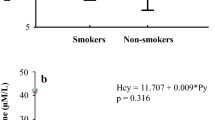Abstract
Convincing evidence of moderate hyperhomocysteinaemia as a risk factor for vascular disease has accumulated within the last decade being independent of conventional risk factors and equally strong as hypercholesterolaemia and smoking. A synergistic interaction with hypertension and smoking in their joint arteriosclerotic effect in patients is demonstrated which makes the result of homocysteine-lowering intervention very promising, especially in those vascular patients with an association of these risk factors.
Conclusion Despite the proven homocysteine-lowering effect of intervention with sample, safe, and cheap vitamin regimen, no data are so far available on the clinical outcome of such treatment. Clinical trials to demonstrate a hopefully beneficial result of homocysteine reduction are urgently needed.
Similar content being viewed by others
Author information
Authors and Affiliations
Rights and permissions
About this article
Cite this article
Boers, G. Moderate hyperhomocysteinaemia and vascular disease: evidence, relevance and the effect of treatment. Eur J Pediatr 157 (Suppl 2), S127–S130 (1998). https://doi.org/10.1007/PL00014292
Issue Date:
DOI: https://doi.org/10.1007/PL00014292




